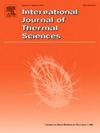基于LBM-FVM混合求解和FGRA的非均质陀螺多孔支架流动传热特性研究
IF 5
2区 工程技术
Q1 ENGINEERING, MECHANICAL
International Journal of Thermal Sciences
Pub Date : 2025-02-09
DOI:10.1016/j.ijthermalsci.2025.109717
引用次数: 0
摘要
三周期最小表面(TPMS)多孔支架在强化传热方面得到了广泛的研究。然而,非均相结构转变对TPMS结构热流体特性的影响机制尚不清楚,需要进一步研究。为实现不同形貌非均相TPMS结构中共轭传热过程的批量模拟,提出了一种结合晶格玻尔兹曼法和有限体积法的混合求解器,避免了TPMS结构复杂的几何建模和贴体网格生成问题。利用混合求解器、正交实验设计和模糊灰色关联分析(FGRA),揭示了非均质陀螺TPMS多孔支架的流动和传热特性,并报告了TPMS结构变量对性能参数的个体贡献程度。结果表明:合理的非均质结构转变可以在提高换热性能的同时降低流动阻力,与均质结构相比,非均质结构中更为复杂的分叉螺旋流型可能是进一步提高换热性能的关键。本工作为TPMS结构中共轭传热过程的批量数值模拟和综合评估提供了一种新的方法,有助于实现基于TPMS的多孔结构的高效拓扑定制以增强传热。本文章由计算机程序翻译,如有差异,请以英文原文为准。
Investigation of flow and heat transfer characteristics in heterogeneous Gyroid porous scaffold based on hybrid LBM-FVM solver and FGRA
Triply periodic minimal surface (TPMS) porous scaffold has been widely investigated for the heat transfer enhancement. However, the influence mechanism of heterogeneous structural transformations on the thermal-fluid characteristics of TPMS structures remains unclear and requires further research. To realize the batch simulation of the conjugate heat transfer process in heterogeneous TPMS structures with different morphologies, a hybrid solver combining the lattice Boltzmann method and the finite volume method is developed to avoid the complex geometry modeling and body-fitted grid generation problems of the TPMS structures. With the help of the hybrid solver, orthogonal experimental design, and fuzzy grey relational analysis (FGRA), the flow and heat transfer characteristics of the heterogeneous Gyroid TPMS porous scaffold are revealed, and the individual contribution degree for the TPMS structural variables to the performance parameters are reported. The results indicate that: reasonable heterogeneous structural transformations can enhance heat transfer while reducing flow resistance, and compared with the homogeneous structures, the more complicated flow patterns of the forked spiral flow in heterogeneous structures might be crucial to further improve the heat transfer performance. This work provides a novel approach for the batch numerical simulation and comprehensive assessment of the conjugate heat transfer process in TPMS structures, which contributes to realizing the efficient topological customization of TPMS-based porous structures for heat transfer enhancement.
求助全文
通过发布文献求助,成功后即可免费获取论文全文。
去求助
来源期刊

International Journal of Thermal Sciences
工程技术-工程:机械
CiteScore
8.10
自引率
11.10%
发文量
531
审稿时长
55 days
期刊介绍:
The International Journal of Thermal Sciences is a journal devoted to the publication of fundamental studies on the physics of transfer processes in general, with an emphasis on thermal aspects and also applied research on various processes, energy systems and the environment. Articles are published in English and French, and are subject to peer review.
The fundamental subjects considered within the scope of the journal are:
* Heat and relevant mass transfer at all scales (nano, micro and macro) and in all types of material (heterogeneous, composites, biological,...) and fluid flow
* Forced, natural or mixed convection in reactive or non-reactive media
* Single or multi–phase fluid flow with or without phase change
* Near–and far–field radiative heat transfer
* Combined modes of heat transfer in complex systems (for example, plasmas, biological, geological,...)
* Multiscale modelling
The applied research topics include:
* Heat exchangers, heat pipes, cooling processes
* Transport phenomena taking place in industrial processes (chemical, food and agricultural, metallurgical, space and aeronautical, automobile industries)
* Nano–and micro–technology for energy, space, biosystems and devices
* Heat transport analysis in advanced systems
* Impact of energy–related processes on environment, and emerging energy systems
The study of thermophysical properties of materials and fluids, thermal measurement techniques, inverse methods, and the developments of experimental methods are within the scope of the International Journal of Thermal Sciences which also covers the modelling, and numerical methods applied to thermal transfer.
 求助内容:
求助内容: 应助结果提醒方式:
应助结果提醒方式:


